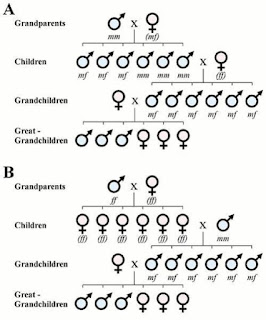수백년의 가계도를 연구한 결과 남성 유전자가 아들 또는 딸을 결정하는 역할을 함을 알 수 있었다. 남자들은 부모에게서 아들이나 딸 중에 어느 성별을 더 많이 낳는 경향인지를 물려받는다. 즉 형제가 많은 남자는 아들을 가질 가능성이 높고, 자매가 많은 남자는 딸을 가질 확률이 높다.
아들 딸 출생 비율? 아버지 유전자로 결정된다
뉴캐슬 대학교에서 수천명의 가정을 대상으로 연구하였다. Corry Gellatly의 연구에 의하면 남성이 부모로부터 더 많은 아들 혹은 더 많은 딸을 갖는 경향을 물려받는다고 한다. 많은 형제들을 가진 남자가 아들을 가질 가능성이 더 높은 반면, 많은 자매들을 가진 남자는 딸을 가질 가능성이 더 높다. 이번 연구는 북미와 유럽에서 1600년부터 927개의 가계도로 556387명의 사람들에 대한 정보를 조사하여 얻은 결과이다.
남자가 X염색체 또는 Y염색체를 전달하느냐에 아기의 성별이 결정된다. X염색체는 엄마의 X염색체와 결합하여 여자아이를 만들고 Y염색체는 엄마 염색체와 결합하여 남자아이를 만든다.
뉴캐슬 대학교의 연구는 한 남성의 정자가 더 많은 X염색체를 포함하고 있는 또는 Y염색체를 포함하고 있는지를 아직 발견되지 않은 유전자가 통제하고 있다고 제안한다. 즉 Y정자를 더 많이 가진 남성의 숫자와 X정자를 더 많이 가진 남성의 수의 비율이 매년 태어나는 아이들의 남녀성별 비율에 영향을 미친다.
X와 Y 염색체 비율을 조절하는 유전자는 세 가지 조합이 가능하다. mm의 남자는 아들을 더 많이 낳고, mf는 같은 비율, ff의 남자는 딸을 더 낳는다. 자세한 내용은 아래 과학사이트 원문이나 논문을 참조하면 된다. 다만 이러한 세 가지 경우가 있기에 평상시에는 남녀 비율이 유지되고 전쟁 후에는 아들이 많이 태어난다. 남녀 비율 유지는 위 그림이 어느 정도 설명하고 있다.
그러면 전쟁 후에 소년이 더 많아지는 이유는 무엇일까. 쉽게 말해 전쟁으로 남자가 죽으면 확률적으로 남자 아이를 낳을 남자가 많아지기 때문이라고 한다. 1차 세계대전이 끝난 후 영국에서 여자아이 100명 당 남자아이는 102명이었다. 형제가 많은 남자이든 자매가 많은 남자이든 전쟁에서 죽는 비율은 같다고 보면 전쟁 후에는 결국 형제가 많은 남자의 비율이 높아진다. 남자가 적어지면 형제가 많은 남자가 상대적으로 많이지고 결과적으로 아들이 많이 태어난다는 의미이다.
이에 대해 몇가지 경우의 예로 설명해보려고 했는데, 글을 쓰면서 다시 생각해보니 논리의 오류가 있어보여 덧붙이지 못했습니다. 아래 출처의 글이나 논문을 읽고 이에 대해 더 잘 이해가 되신 분은 댓글로 설명해주면 좋겠습니다.
출처 : Newcastle University. (2008, December 12). Boy Or Girl? It's In The Father's Genes. ScienceDaily
Summary : A study of hundreds of years of family trees suggests a man's genes play a role in him having sons or daughters. Men inherit a tendency to have more sons or more daughters from their parents. This means that a man with many brothers is more likely to have sons, while a man with many sisters is more likely to have daughters.
논문 : Gellatly et al. Trends in Population Sex Ratios May be Explained by Changes in the Frequencies of Polymorphic Alleles of a Sex Ratio Gene. Evolutionary Biology
Abstract : A test for heritability of the sex ratio in human genealogical data is reported here, with the finding that there is significant heritability of the parental sex ratio by male, but not female offspring. A population genetic model was used to examine the hypothesis that this is the result of an autosomal gene with polymorphic alleles, which affects the sex ratio of offspring through the male reproductive system. The model simulations show that an equilibrium sex ratio may be maintained by frequency dependent selection acting on the heritable variation provided by the gene. It is also shown that increased mortality of pre-reproductive males causes an increase in male births in following generations, which explains why increases in the sex ratio have been seen after wars, also why higher infant and juvenile mortality of males may be the cause of the male-bias typically seen in the human primary sex ratio. It is concluded that various trends seen in population sex ratios are the result of changes in the relative frequencies of the polymorphic alleles of the proposed gene. It is argued that this occurs by common inheritance and that parental resource expenditure per sex of offspring is not a factor in the heritability of sex ratio variation.

댓글 없음:
댓글 쓰기